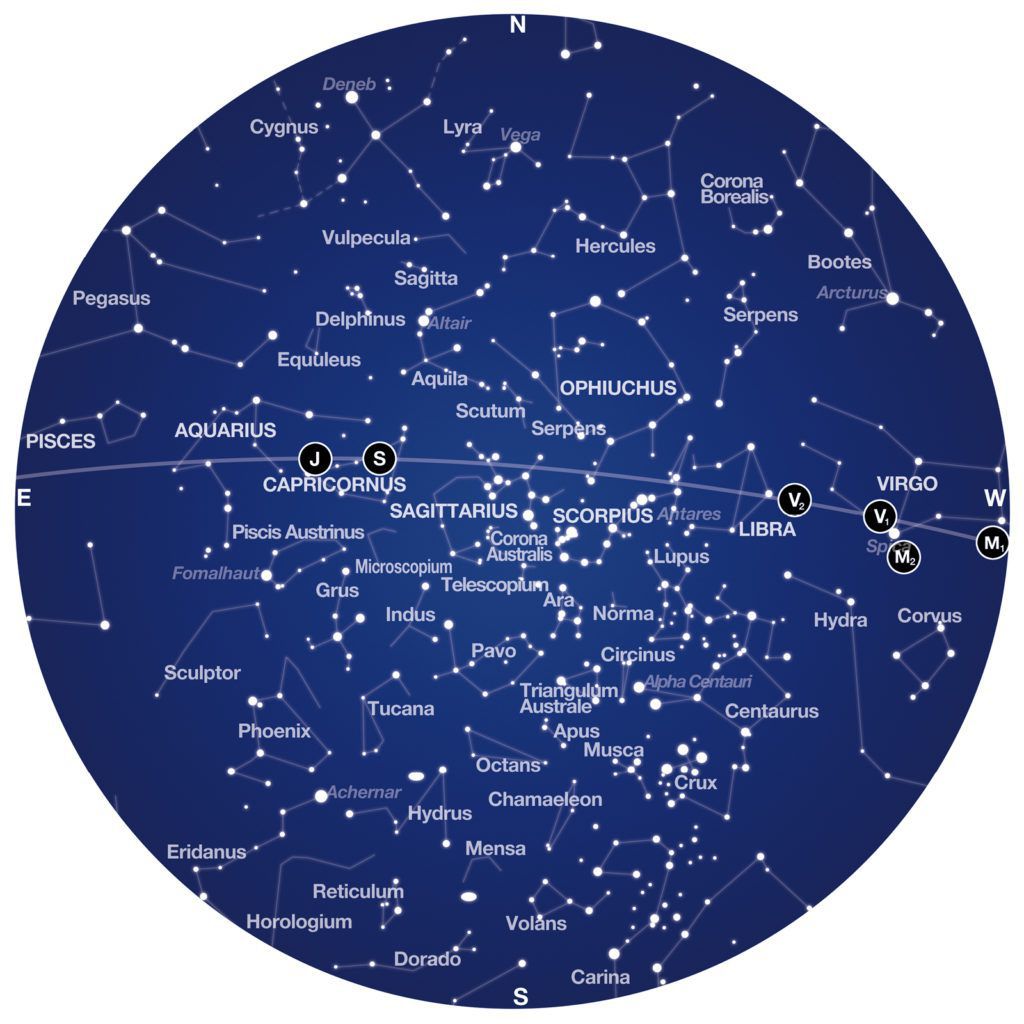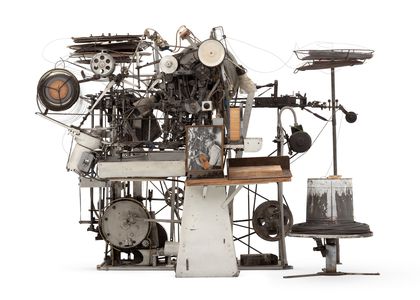
Monthly sky maps from the 2021 Australasian Sky Guide published by MAAS Media.
What’s in the sky this September?
Constellations
Constellations represent groups of stars that have been given a name and more recently, a border. For millennia they have been used as a tool to share significant cultural stories, events and as markers. Today, the 88 western constellations that trace their roots to the ancient middle east are used here help astronomers map the sky and search for astronomical objects. This September these constellations dominate the spring sky:
- Virgo – the maiden, very low in the west is the second largest constellation in the sky and one of the two in which the ecliptic and celestial equator cross. This one marks the current position of the September equinox. It is home to a cluster of galaxies of which M87 is the largest at around 60 million light years with a central black hole at least 7 billion times the mass of the Sun. It has one bright star, the 16th brightest in the night sky, Spica which is about 250 light years away. Like most stars, it is a binary. The brighter being about 7 times the diameter of the Sun and 10 times more massive. Its hot surface temperature of around 20,000 kelvin makes it blue-white in colour.
- Scorpius – high in the western sky, with its hooked tail and red supergiant Antares as the heart, the constellation is easily seen to look like its namesake. In Greek Mythology, the scorpion plays a role in many stories, however it is best known for its pursuit of Orion through the night sky.
- Sagittarius – also known as the archer, can be found 15 degrees to the east of Scorpius’s stinger and directly overhead an hour or so after sunset. In Greek Mythology, the archer is a centaur, pointing his arrow toward the heart of Scorpius. The centre of our Milky Way galaxy appears in this constellation at a distance of about 26,000 light years with is 4 million solar mass black hole called Sagittarius-A-Star.
- Capricornus – the sea goat often associated with the Greek god of nature, Pan. He transformed his lower half into a fish to swim to safety during an attack on Jupiter by Typhon. Halfway through the transformation he played a loud note on his conch shell which distracted Typhon long enough for Jupiter to strike him down with thunderbolts. As a reward, Jupiter placed him in the sky as he was, half goat, half fish. It is a faint constellation and looks more like a partially collapsed triangle. It has no easily seen deep sky objects other than the globular cluster M30, approximately 27,000 light years away. It is the smallest and second faintest constellation of the Zodiac.
- Aquarius – the water carrier is high in the eastern sky. It is described as the Trojan youth Ganymede (now also the name given to the largest moon in the Solar System) who was carried by the eagle Aquila, which can also be seen high in the north, to Mt Olympus to serve water to the Greek gods. It has two globular clusters and two planetary nebulae that can be seen with a moderate telescope but only from a dark location, NGC 7009 the Saturn nebula, and NGC 7293 the Helix nebula, both of which are considered to be dead stars. The Helix is the largest planetary nebula in the sky at a distance of about 650 light years.
- Crux – or the Southern Cross, the smallest constellation and its nearby pointers of Alpha and Beta Centauri are very low in the south west in the early evening. To find south, draw an imaginary line from the top of Crux though the bottom and across the sky. Midway between the Pointers draw a line perpendicular to the line that joins them. Where these two long lines intersect is close to the southern celestial pole. From this point drop to the horizon for south.
Planets
- Mercury is visible low in the west, in Virgo, shortly after sunset early in the month. It will be at its greatest angle, elongation, on 15 September.
- Venus is low in the northwest after sunset. It starts the month in Virgo before moving into Libra. On 10 September a young crescent Moon is to the right, or north, of Venus with Mercury below. On 24 September it is close to the star Zubenelgenubi, a bright star in Libra.
- Mars is too close to the Sun to view all month.
- Jupiter spends the month in Capricornus and will be near the Moon on 18 September. A small telescope should be able to resolve its 4 large Moons and two equatorial belts.
- Saturn is high overhead also in Capricornus all month. The gibbous Moon is above and to the right, or east, on 17 September.
Moon
For the monthly movements of the Moon, check out our Moon Phase Calendar.
Equinox
The Spring equinox, when the Sun crosses the celestial equator from the northern to the southern sky, occurs on 23 September at 5:20am AEST. On this day, the Sun rises and sets due east and west. The length of day and night is almost equal but not quite.
Deep Sky
Explore the universe through the lens of your telescope and take in some of the gems of the September night sky:
- Vega in the north. Half the age but twice the size of the Sun, it is located about 25 light years away. It was the first star, after the Sun, to be photographed through a telescope and have its rainbow of light (spectrum) to be recorded. It was the north polar star 12,000 years ago and shall be again in another 13,000.
- Achernar rising in the southeast. It is a hot blue star and is possibly, the least spherical star in our galaxy. Roughly 7 times the size of the Sun, its equatorial diameter is about 56% more than its polar diameter because of the rapid spin at around 250km/s, or 15 times faster than the Sun.
- Jewel Box Open Cluster (NGC4755) – is about 7600 light years away low in the south west, within Crux, the open star cluster of about 100 stars contains blue and red (DU Crucis) super giants. Widely considered to be the second prettiest open cluster after the Pleaides, M45.
- Alpha Centauri star system low in the south west – A star system consisting of three stars, Alpha Centauri A, Alpha Centauri B and the closest star to our Sun, Proxima Centauri at 4.2 light-years away. Proxima Centauri is a red dwarf star and is only visible through large telescopes. It is believed to be orbiting the two larger stars.
- The Milky Way – as seen from dark rural locations on a moonless night is perfect at this time of year early in the evening with the centre in Sagittarius high overhead. The faint glow of billions of stars extends from the low southwest across the sky to the northeast. No telescope required and look for the head and neck of the emu in the sky.
- 47 Tucanae (NGC104). A globular cluster at about 13,000 light years away and 13 billion years old. It contains millions of stars and is the second brightest globular cluster in the sky. Located in the constellation of the Toucan, it is rising in the south southeast. Its compact core makes it the most easily seen globular cluster even from towns and cities on moonless nights.
- Magellanic clouds. The smaller cloud at 201,000 light years is low in the south southeast in the early evening but only visible from dark locations on a moonless night. It looks like part of the Milky Way has detached and drifted away. It is a separate galaxy about 7 billion times the mass of the Sun. It was perhaps a barred spiral galaxy in the past before being disrupted by the gravitational pull of the Milky Way. The larger, closer cloud is low in the early evening and best seen after midnight in the south southeast. It is a spectacular object as seen from a dark location and home to one of the largest star-making clouds in the local group of galaxies, the Tarantula Nebula, NGC2070 at about 160,000 light years.
Learn More
- Purchase the 2021 Australasian Sky Guide by Dr Nick Lomb, featuring an annual report of what’s in the sky and the latest astronomical findings. Produced by MAAS Media.
- View the September sky chart, which shows the stars, constellations and planets visible in the night sky from anywhere in Australia.
- Check out these resources for getting started.



Mr Wyatt what a great read ! you knowledge of everything Celestial is incomparable. cant wait to see more from this lord of the heavens.
Wow! Reading all this has opened my eyes to another world. So interesting and it brings it all to life. Just so interesting and fascinating. Thank you Mr Wyatt.